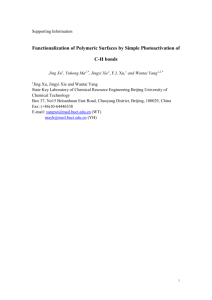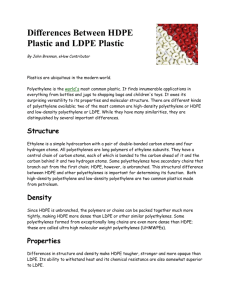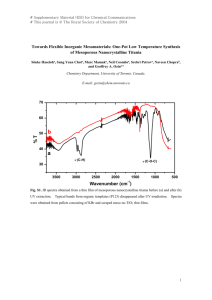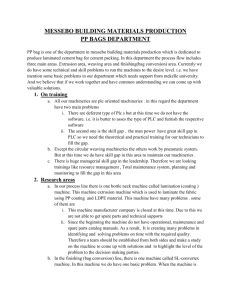srep04982-s1
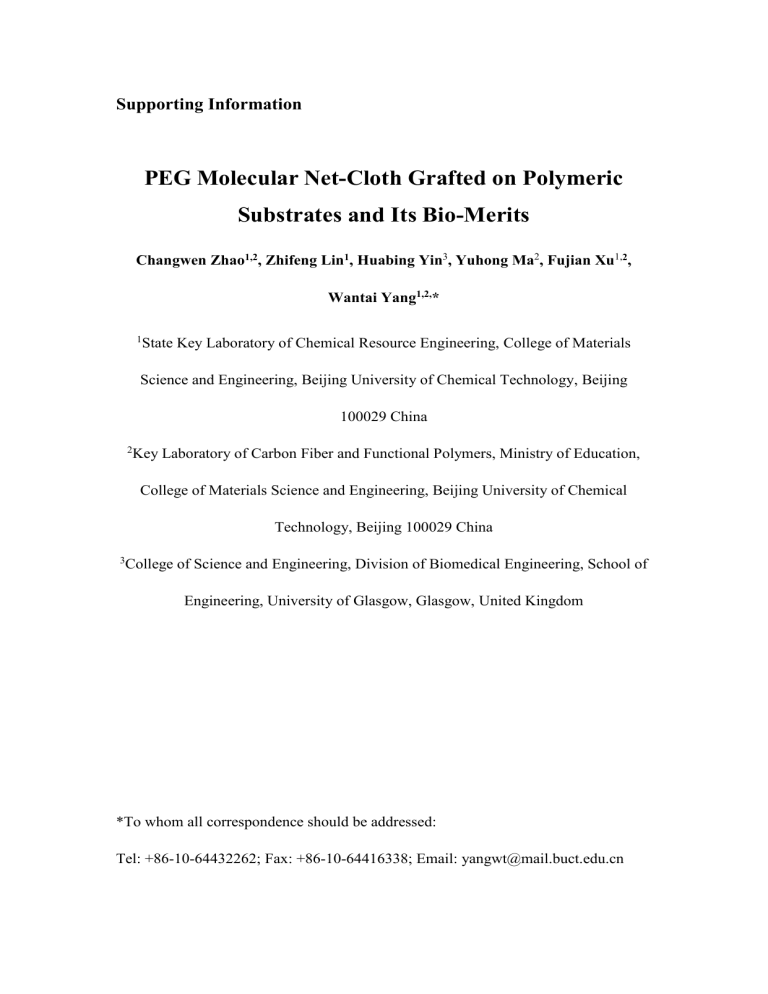
Supporting Information
PEG Molecular Net-Cloth Grafted on Polymeric
Substrates and Its Bio-Merits
Changwen Zhao 1,2 , Zhifeng Lin 1 , Huabing Yin
3
, Yuhong Ma
2
, Fujian Xu
1, 2 ,
Wantai Yang 1,2, *
1 State Key Laboratory of Chemical Resource Engineering, College of Materials
Science and Engineering, Beijing University of Chemical Technology, Beijing
100029 China
2 Key Laboratory of Carbon Fiber and Functional Polymers, Ministry of Education,
College of Materials Science and Engineering, Beijing University of Chemical
Technology, Beijing 100029 China
3 College of Science and Engineering, Division of Biomedical Engineering, School of
Engineering, University of Glasgow, Glasgow, United Kingdom
*To whom all correspondence should be addressed:
Tel: +86-10-64432262; Fax: +86-10-64416338; Email: yangwt@mail.buct.edu.cn
Synthesis and Characterization
Materials. Low-density polyethylene films (LDPE, 60 μm in thickness) were purchased from Baoding Baoshuo Plastic Factory (China) and were extracted with acetone for 72 h before use. Isopropyl thioxanthone (ITX, purity > 98%) was obtained from TH-UNIS Insight Co. (Beijing, China). Poly (ethylene glycol) diacrylate with molecular weight of 575 (PEGDA 575), glycidyl methacrylate (GMA, 98%), GOD
(type X-S, 180 units/mg, from Aspergillus niger ) and HRP (type VI) were purchased from Sigma-Aldrich. PEGDA 575 and GMA were used after removal of the inhibitors in a ready-to-use disposable inhibitor-removal column (Sigma-Aldrich).
Poly(ethylene glycol) diacrylate with molecular weight of 1000 and 4000 (PEGDA
1000 and 4000) were synthesized from PEG (4000 and 1000 Da, respectively, purchased from Alfa Aesar) as described
1
. The degree of substitution for PEGDA
1000 was 98% and for PEGDA 4000 was 93%. Fluorescein isothiocyanate-labeled bovine serum albumin (FITC-BSA) and rhodamine conjugated rabbit anti-goat IgG
(Rh-IgG) were purchased from Beijing Biosynthesis Biotechnology Co. D-glucose anhydrous, 4-aminoantipyrine and phenol were purchased from Sinopharm Chemical
Reagent Co., Ltd. HepG2 cell lines were purchased from the American Type Culture
Collection (ATCC, Rockville, MD).
Characterization.
Attenuated total reflectance Fourier transform infrared (ATR-FTIR) spectra were recorded on a Nicolet Nexus 670 spectrometer with 8 cm -1 resolution, and a variable-angle attenuated total reflectance (ATR) accessory (PIKE ATRMax II) was utilized with ZnSe ( n = 2.43) as the internal reflection element wafer. X-ray
photoelectron spectra (XPS) were recorded on an ESCA Lab 22i-XL instrument (VG
Scientific) using K-Alα as the excitation source. Scanning electron microscopy (SEM) was performed on a Hitachi S-4700 (Japan) instrument. Atomic Force Microscopy
(AFM) was performed on a CP-II (DI, U.S.) under ambient conditions in contact mode. Static contact angle measurements were conducted using an OCA20 instrument
(DataPhysics Instruments GmbH, Germany) with a digital photo analyzer. Fluorescent images were taken using an Olympus IX2 fluorescent microscope.
Visible Light Induced Graft Polymerization of PEGDA.
Firstly, ITX acetone solution (20 μL, 0.5 M) was coated onto the LDPE film (4 × 4 cm
2
) then spread into an even and very thin liquid layer (10 μm) under suitable pressure from a quartz plate, thus giving rise to a ‘‘sandwich’’ structure. The assembly was irradiated from above by UV light (high-pressure mercury lamp) at room temperature for a certain time. The distance between the UV light source and the sample surface was around 9 cm and the irradiated area was 10 × 10 cm
2
. The irradiation intensity was measured by a UV radiometer with a peak intensity of 254 nm (from the Photoelectric Instrument
Factory of Beijing Normal University). Prior to every experiment, the irradiation intensity on the sample surface was adjusted to 9000 μW/cm 2 by slightly varying the distance between the UV lamp and the sample. After irradiation, LDPE film was subjected to extraction with acetone for at least 4 h to remove any residual compounds.
The washed film was blown dry using nitrogen.
We investigated the amount of initiating groups immobilized on LDPE by the methods described previously 2 . The graft density was determined to be 0.052 ± 0.006
μmol/cm 2 . All samples (denoted as LDPE-ITXSP) were stored in the dark prior to further use. The reaction mechanism was that (shown in Fig. S1a): under UV irradiation ITX absorbs a photon and forms an excited singlet state ITX
S
, then yields a more stable excited triplet state ITX
T
through intersystem crossing. The triplet state interacts with weak C-H bonds in LDPE, resulting in hydrogen abstraction, which generated an ITXSP free radical and an alkyl free radical. These two kinds of radical readily recombined to form a new C-C weak bond, thus ITXSP coupled to LDPE surface.
For visible light induced graft polymerization, the resulted LDPE with dormant groups is used as the bottom film, and a quartz plate is used to cover it. PEGDA solution (40 μL) was coated between LDPE-ITXSP film and a quartz plate, which constitute a sandwich structure. Then this setup was placed under visible light irradiation (xenon lamp plus filter with a pass band of 380–700 nm). The irradiation intensity on the sample surface was measured by a radiometer with a peak intensity of
420 nm (from the Photoelectric Instrument Factory of Beijing Normal University).
The values of 2900 or 3900 μW/cm
2
was achieved by adjusting the distance between the lamp and the sample. The “ sandwich ” structures not only isolated monomer solution from the air but also provide a confined reaction space for efficient contact between the monomer and surface tethered radicals. This guaranteed the solid/solution interface reaction could proceed effectively. After irradiation the LDPE film was extracted in ethanol for 24 h. Then, the film was rinsed with excess water and immersed in water for 48 h. Finally, the film was frozen in liquid nitrogen and
lyophilized to constant weight. The graft density ( D g
) of PEGDA polymer network was calculated as follows:
D g
= ( W
1
– W
0
) / S
× 100% where W
0
is the weight of the blank film; W
1
is the weight of the film after grafting polymerization of PEGDA; S is the surface area of the film. It should be noted that the graft density is directly proportional to the conversion rate of PEGDA, which is defined by:
Conversion of monomer = ( W
1
– W
0
) / W
2
× 100% where W
0
and W
1
are denoted as the above and W
2
is the PEGDA weight in the 40 μL
PEGDA solution with different concentrations.
To get a patterned surface, a chrome photomask was placed on the surface of the sandwich structure to control the irradiated area. The patterned films were dried under vacuum at 30 o
C for 24 h to a constant weight. For the swelling test, the patterned film was immersed in deionized water for 48 h at room temperature to ensure a sufficient network chain relaxation. The stability of microarrays on LDPE was assessed by incubating them in phosphate-buffered saline (PBS, pH = 7.4)) at 37 o
C and analyzing the integrity of the arrays over time by microscopy. Experiments performed to assess array stability were conducted in triplicates.
Protein absorption.
FITC-BSA were dissolved in 0.01 M PBS (pH = 7.4) at concentrations of 1 mg/mL. A few drops of the protein solution were evenly spread onto the patterned substrates and stored at room temperature for 30 min. Then the patterned substrates were rinsed with PBS solution and water, and blown dry in a
stream of nitrogen and immediately analyzed under a fluorescence microscope.
Cell culture.
The cell-adhesion property of the functionalized LDPE surfaces was assessed by HepG2 cell lines. Cells were cultured in Dulbecco's modified Eagle's medium (DMEM) supplemented with 10% fetal bovine serum. All media contained
100 U/ml of penicillin and 100 μg/ml of streptomycin. Cells were incubated at 37 o
C and supplemented with 5% CO
2
in the humidified chamber. Prior to being placed into the wells of a 24-well culture plate, the surface was sterilized via exposure to UV light for 20 min. HepG2 cells at a density of 1 ×10
5
cells/well in culture media were seeded and cultured on the functionalized LDPE films for 24 h. The surfaces after incubation were washed twice with PBS solution to remove the dead and loosely attached cells.
The cell adhesion was imaged using a Leica DMIL fluorescence microscope.
Protein immobilization and detection. Firstly, PEGDA 575 was grafted onto the
LDPE-ITXSP, the resulting sample denoted as PEGMNC/LDPE. Then GMA and
PEGDA 575 (weight ratio of GMA to PEGDA was 2 : 1) was regionally grafted onto
LDPE-ITXSP or PEGMNC/LDPE with similar experimental procedures. The only difference was that the irradiation area was controlled by way of a metallic mask.
After the GMA activated films were extracted with acetone and dried by nitrogen blowing, they were immersed into the Rh-IgG PBS solution (pH 7.4) with a concentration of 0.5 mg/mL, and then incubated for 2 hours at 30 o
C. Finally, thorough washing with PBS solution (pH 7.4) was performed to remove the weakly adsorbed proteins. Fluorescent images were taken using an Olympus IX2 fluorescent microscope with 10 x objective lens with NA = 0.25.
In situ entrapment of Enzyme.
The encapsulation of enzyme process was similar to that of PEGDA graft polymerization and only difference was the enzyme also added in the monomer solution. The prepolymer solution was prepared as follows: HRP and
GOD were dissolved in pH = 7.4 phosphate buffer (PBS, 0.01 M) solution to reach concentration of 1.8 mg/mL and 1.0 mg/mL respectively. Then glutaraldehyde was added to the enzyme solution with a concentration of 0.5% (v/v). The mixture was stirred for 1 h at 4 °C. In parallel, PEGDA 575 was added to PBS solution to reach a concentration of 60 wt%. Finally 0.5 mL crosslinked enzyme solution was slowly added to 0.5 mL PEGDA 575 solution under stirring. The mixture was further stirred for 2 h at 4 °C to ensure the homogeneous dispersion of the enzyme molecules. The irradiation intensity was 3900 μW/cm 2 (λ = 420 nm) and irradiation time was 2 h for visible light induced graft polymerization. For UV induced polymerization, the irradiation time was 3 min at intensity of 9000 μW/cm
2
(λ = 254 nm).
The amount of enzyme immobilized in PEG crosslinked layers was assayed by
Coomassie brilliant blue G-250 (CBBG) staining
3
. Briefly, CBBG aqueous solution was prepared by mixing CBBG (25 mg) in ethanol (12.5 mL, 95%) and phosphoric acid (25 mL, 85% w/v), followed by dilution with water (250 mL). A known concentration of bovine serum albumin (BSA, 0.1 mL) was added to the CBBG solution (4 mL) for 10 min, and then centrifuged at 1500 rpm for 20 min. The precipitated BSA-CBBG complex was separated from the CBBG free upper layer.
The absorbance of the supernatant at 470 nm was used as the standard calibration curve. Three pieces of enzyme-immobilized film (1 × 1 cm 2 ) were immersed in the
CBBG solution (4 mL) for 3 h, and the amount of immobilized enzyme was calculated from the measurement of remaining CBBG concentration using the predetermined standard calibration curve.
Detection of D-Glucose.
40 μL of D-glucose solution with a known concentration was added to 4 mL 4-aminoantipyrine (0.05 mg / mL) and phenol (0.1 mg / mL) solution and the resulted solution was placed in a 37 o C shaking incubator for half an hour. Then a 2 × 2 cm
2
enzyme entrapped film was immersed into the solution and the absorbance at 505 nm was monitored.
Figure S1. Synthesis route of PEG molecular net-cloth covalently attached on
LDPE.
(a) Scheme of photo-reduction reaction of ITX on LDPE. (b) Scheme of synthesis process of PEGDA network.
Figure S2. Typical S 2p high resolution XPS spectra of films.
(a) pristine LDPE.
(b) LDPE-ITXSP. The appearance of S 2p peak with binding energy at 165.2 eV verified the immobilization of ITXSP on LDPE.
Figure S3. UV-visible spectra of pristine LDPE film and LDPE-ITXSP films.
The newly appeared absorption in the UV–vis region of LDPE-ITXSP still existed even after thorough washing with abundant acetone, which clearly verified that the ITXSP groups had been covalently grafted onto the surface.
Figure S4.
XPS spectra of LDPE and PEGMNC/LDPE surfaces.
(a) Wide scan.
(b) C 1s core-level spectrum of a pristine LDPE surface. (c) C 1s core-level spectrum of a PEGMNC/LDPE surface. After polymerization the relative intensity of O 1s to C
1s increased due to the introduction of the ether chain (Fig. S3a). The C 1s core-level spectrum of the pristine LDPE film (Fig. S3b) can be curve fitted with four peak components, with binding energies (BEs) at 283.0 eV, 284.6 eV, 286.2 eV, 287.7 eV, attributable to the C-Si (from mold release agent), C-H, C-O, and O=C-O species, respectively
4,5
. After the graft polymerization of PEGDA (Fig. S3c), the C 1s component at about 286.2 eV, attributable to the C-O species of the grafted PEGDA network, becomes predominant. The other two peaks with BEs at 284.6 eV and 288.6 eV C can be ascribed to the C-H species and O=C–O species of the grafted PEGDA backbone structure, respectively
5
.
Figure S5.
Surface morphology of films.
(a) SEM image of PEGMNC/LDPE surface. (b) AFM 3D height image of LDPE surface. (c) AFM 3D height image of
PEGMNC/LDPE surface. The PEGMNC/LDPE film surface exhibits a root mean square surface roughness value of about 9.4 nm, which is smaller than the pristine
LDPE with a root mean square surface roughness value of about 14.5 nm. Slight decrease in the surface roughness after introduction of the network indicated that graft polymerization proceeded uniformly on the LDPE surfaces.
Figure S6. The volume change of gel pattern before (a) and after (b) immersed in water for 24 h measured by AFM.
When a crosslinked network was immersed in a good solvent of the corresponding polymer, solvent molecules can diffuse into the network and network chain undergo relaxation, resulting in the cross-linked network swelling. The PEGDA 575 network grafted onto LDPE is very thin, so it is difficult to use the weighing method to obtain an accurate swelling rate. The three-dimensional pattern structure of the gel allowed us to measure height and width changes before and after swelling to assess its swelling properties. The height of the dry gel pattern
(1.451 μm) and the swollen gel pattern (1.457 μm) were identical within the experimental errors. The diameter of cylindrical pattern also exhibited no expansion after immersion in water for 24 h. We also investigated the swelling behavior of the gel in ethanol and PBS and no obvious volume change could be found either.
Figure S7. Anti-fouling properties of surface attached PEG molecular net-cloth.
(a) Static contact angle of (PEG molecular net-cloth)/LDPE obtained at various irradiation time. (b) Fluorescence micrograph of FITC-BSA that is selectively adsorbed on patterned Gel/LDPE surface. (c) HepG2 cultured on patterned (PEG molecular net-cloth)/LDPE surface.
All the formed PEG molecular net-cloths are hydrophilic, having a similar water contact angle of 50 o
regardless of their irradiation time and consequently their thickness (Supplementary Fig. S7a). This again indicates a uniform coverage of the
PEGDA layer on LDPE films. The anti-fouling property of the PEG molecular net-cloth was evaluated by the adsorption of a model protein, fluorescein isothiocynate labeled bovine serum albumin (FITC-BSA). As shown in
Supplementary Fig. S7b, the unmodified LDPE region showed strong fluorescence
(due to the absorbed FITC-BSA) whereas the PEG molecular net-cloth strips remain dark, indicating an excellent resistance to protein absorptionon the PEG molecular net
cloth. Similar, no cells adhered to the PEG molecular net-cloth patterns after 24 h in culture (Supplementary Fig. S7c), demonstrating its excellent resistance to cell adhesion.
References:
1. Shu, X. Z., Liu, Y., Palumbo, F., Luo, Y. & Prestwich, G. D. In-situ crosslinkable hyaluronan hydrogel for tissue engineering. Biomaterials , 25, 1139 -1348 (2004).
2. Bai, H. D., Huang, Z. H. & Yang, W. T. Visible light ‐ induced living surface grafting polymerization for the potential biological applications. J. Polym. Sci., Part A: Polym.
Chem.47, 6852-6862 (2009).
3. Sedmak, J. J. & Grossberg, S. E. A rapid, sensitive, and versatile assay for protein using Coomassie brilliant blue G250, Anal. Biochem., 79, 544-552 (1977).
4. Ly, B., Belgacem, M. N., Bras, J. & Brochier Salon, M. C. Grafting of cellulose by fluorine-bearing silane coupling agents. Mater. Sci. Eng., C 30, 343-347 (2010).
5. Wang, P., Tan, K. L., Kang, E. T. & Neoh, K. G. Surface functionalization of low density polyethylene films with grafted poly (ethylene glycol) derivatives. J. Mater.
Chem.
11, 2951-2957 (2001).
